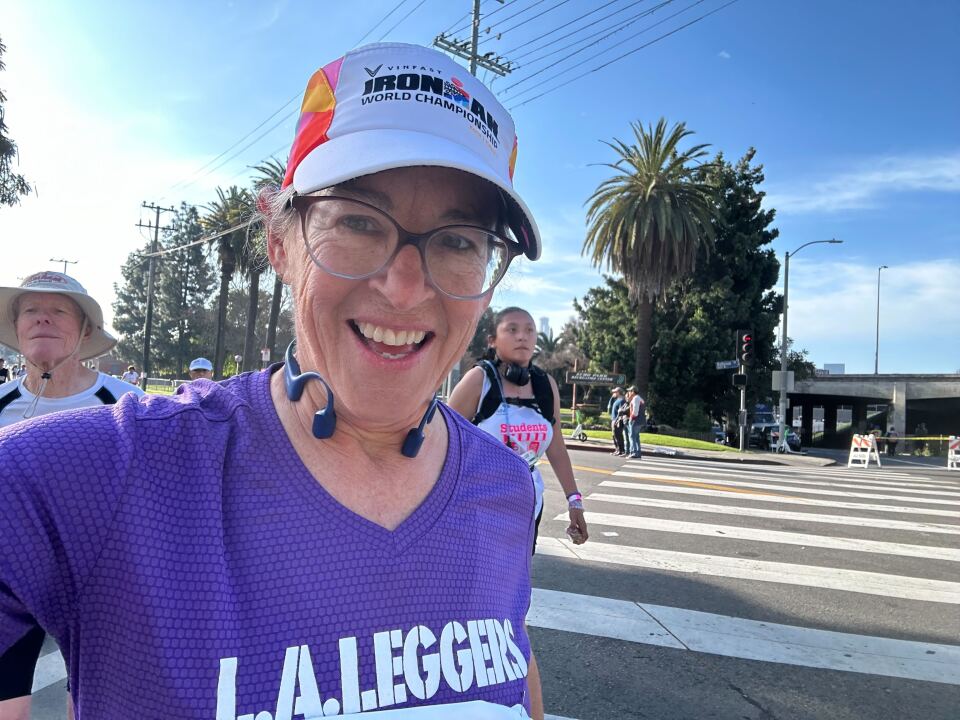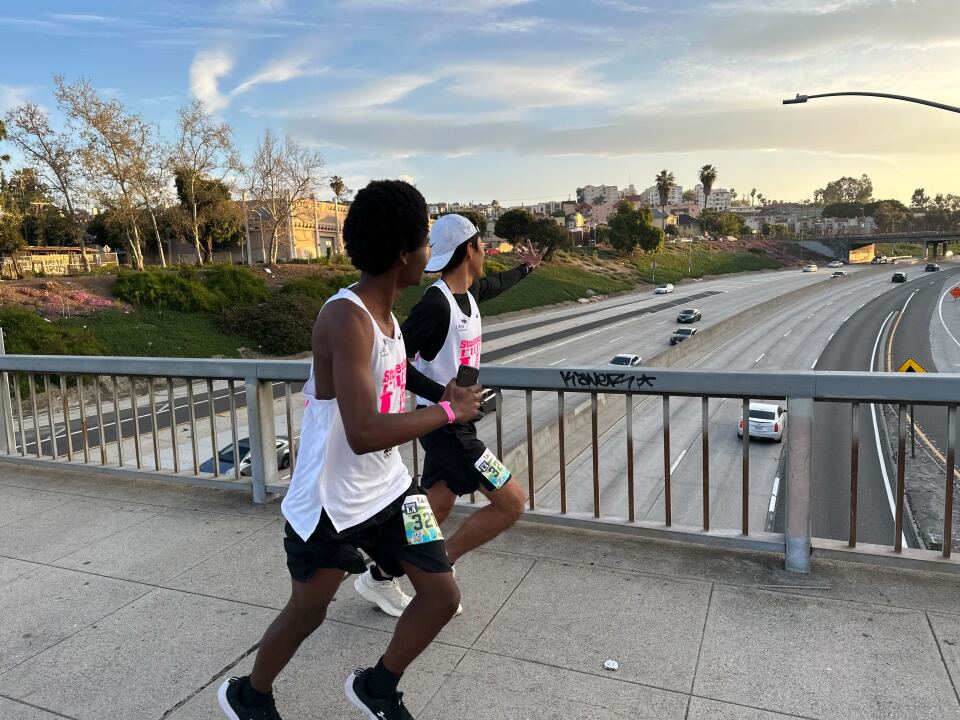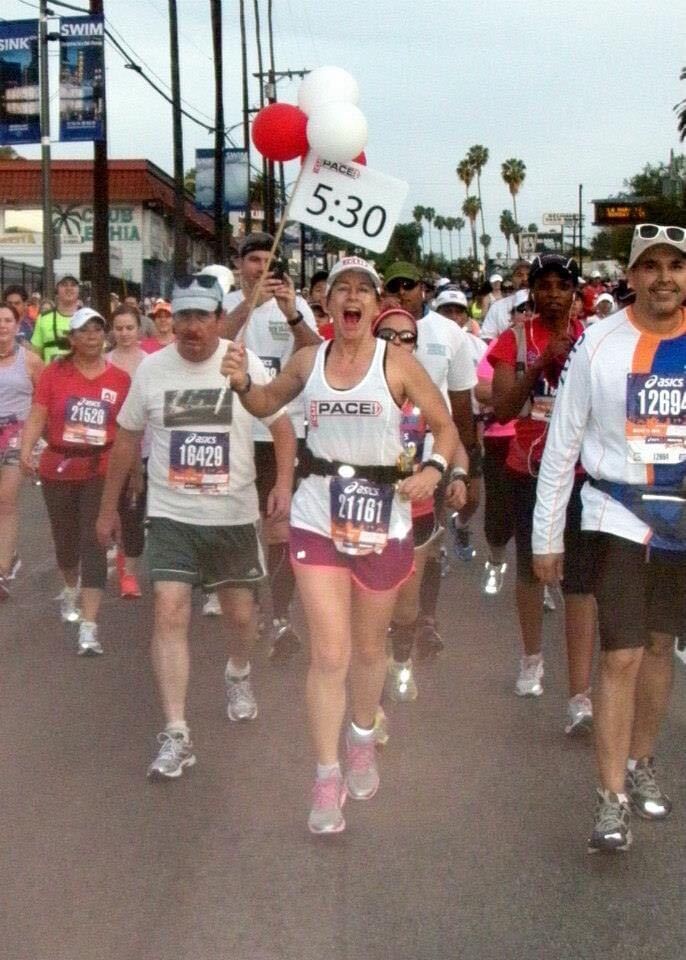Truth matters. Community matters. Your support makes both possible. LAist is one of the few places where news remains independent and free from political and corporate influence. Stand up for truth and for LAist. Make your year-end tax-deductible gift now.
Five Reasons Why LA Marathon Is Like No Other. Take It From Someone Who's Run 160 Of Them

I’ve run a lot of marathons in a lot of places, so I have a strong basis for comparison, but I’m also a SoCal native so, of course, I have a strong local bias. But after 162 marathons, (my 163rd is tomorrow!) these are the things that make the L.A. Marathon very special to me.
The diversity
Marathoning can be a very white sport. There are lots of theories as to why that I won’t go into here (Runner’s World has a few.)
But in Los Angeles, distance running is for everybody — some 26,000 participants this year, the second largest field in the marathon’s history. You will see it at the free pre-marathon expo at Dodger Stadium where entire families accompany their athlete to pick up their race packets. When I used to volunteer at my running club’s booth at the expo, my conversations with them were as likely to be in Spanish as in English.
And while diversity often means race or ethnicity, I also mean it in the broader sense. You will see every body type at the L.A. Marathon. Sure, the skinnier people are up front running fast. But you will see every size of person taking on the marathon challenge.

There is also a wide diversity of speeds. Forty percent of the field are attempting their very first marathon. The official course keeps streets open for six and a half hours. But lots of people take longer. They will run, or run with walk breaks and even walk the whole route, taking seven or eight hours.
When the streets reopen to traffic at 6.5 hours after the last person crosses the start line, folks move to the sidewalk and continue on to the finish, where volunteers greet them with medals and food, even if it’s a few hours after the official clocks have come down. Some of those late finishers will be the 95 “Legacy” participants who have run every single L.A. Marathon.

The kids
Age diversity also sets the L.A. Marathon apart. The oldest man is 90 and the oldest woman is 85. But on the young side, some 3,200 public school kids from nearly 200 public middle and high schools who trained with Students Run L.A will flood the marathon zone in their white shirts. It’s astonishing to see so many young people running so far.
Normally, a kid has to be 16 to register for the marathon but the exceptions are those who train with Students Run L.A. It is a nonprofit organization that trains kids to run long distance races. Training starts in September in small, school-based volunteer-led groups. The volunteers include a mix of teachers, parents and other community saints and over the months, the kids do local training runs and then come together en masse at six races of increasing distances, topping out at 18.6 miles in the Friendship Run at Hanson Dam.
I’ve seen this program develop since the early '90s, and I admire how well-prepared the kids show up to the start line these days.
The landmarks
So many famous things to see on the marathon route. Dodger Stadium, Chinatown, City Hall and other civic buildings, plus Little Tokyo, Disney Hall, Our Lady of the Angels Cathedral.
On Glendale Boulevard in Echo Park, you pass Angelus Temple, founded by pioneering broadcast evangelist Aimee Semple McPherson in 1923. After around 13 miles, you’d find yourself in Hollywood on Hollywood Boulevard, passing El Capitan Theater, where Jimmy Kimmel has pranked runners in past years, offering up money for a marathon bib or serving chilled Alaskan King Crab on ice, or super-glueing water bottles to a table.

You’ll go through Sunset Strip and past the West Hollywood cheerleaders, and run on Rodeo Drive past ritzy stores in Beverly Hills. From there, it’s on to the Veterans Administration in West L.A.
The Los Angeles Marathon course, until the pandemic, was a stellar, international destination race, with a route going all the way to Santa Monica. They called it the “Stadium to the Sea." But the pandemic ended Santa Monica’s participation, which is sad because it was pretty epic to be able to run from downtown to the ocean.
These days, you hang a U-turn at the VA campus at mile 22 and head back uphill four more miles on Santa Monica Boulevard to Century City and the finish line at Avenue of the Stars. So now they call it “Stadium to the Stars.” As before, when you run across the finish line, you get your medal and banana and you’re all done, but the limping and bragging.

The communities
Students Run L.A. is the largest group I know of that participates in the marathon, but another thing that sets this race apart is how many large scale clubs are training runners and walkers to complete the marathon.
The first of the really big clubs was the L.A. Leggers. (Yes, it’s a pun on the L.A. Lakers.) It was formed in 1989 to take experienced and new athletes through the months of training. It was offering something very new: running with walk breaks, based on the writings of Olympian Jeff Galloway.
This was revolutionary back in the years when you wouldn’t consider yourself a real runner if you couldn’t go under four hours. Adding walk breaks to running helped people go farther with less fatigue and injury.
I joined the Leggers in mid-1990 and ran my first L.A. Marathon in 1991. So many people wanted to join and eventually other large groups formed including L.A. Roadrunners, the Pasadena Pacers, Loma Linda Lopers, Frontrunners and more recently, Keep It Run Hundred, Skid Row Runners and many other groups.
Then there are the many charity groups. The marathon itself is now run by the McCourt Foundation, raising money for research of neurological diseases. And other charities use participation in the marathon to raise funds as well.

The spectators
One of the things I most enjoy about running a marathon is seeing all the people who come out to cheer. Sometimes I can see the same groups of people a dozen times as they drive, ride or take transit from place to place to see their person.
Some carry funny signs, like, “Never trust a fart” (bathroom humor is big among marathoners) or “Your feet hurt so much because you’re kicking so much butt!” Sometimes kids hold out their hands for a high five, which I never comply because, well, they have no idea where my hands have been that day, and vice versa.
Metro hacks and other tips
It’s possible to use Metro trains to follow your athlete partway along the marathon course without having to deal with hassling road closures.
- The train stations that will be closest to runners will be on the A (Gold) Line Chinatown, Union Station, and Little Tokyo, for the early part of the course. The B (Red) line goes to Grand Park, which puts you near the taiko drummers at Disney Hall.
- From Downtown, the B Line takes you to three stops along Hollywood Blvd. From there, the marathon course diverges from the light rail and you’d need a vehicle, bike or confidence in your bus-riding ability to follow the route to the finish at the Westfield Century City shopping mall.

Track your runner
If you want to track a person during the race, there’s an app for that, but only if they are willing to carry a phone with them. Download the “Active Experience App” from your app store and then search for the 2024 Los Angeles Marathon.
You can see when all runners and walkers hit various milestones in the race, as well as race results Check your athlete’s race results here.
Parking, street closures and more
Go to our comprehensive guide for other information on the marathon here.








